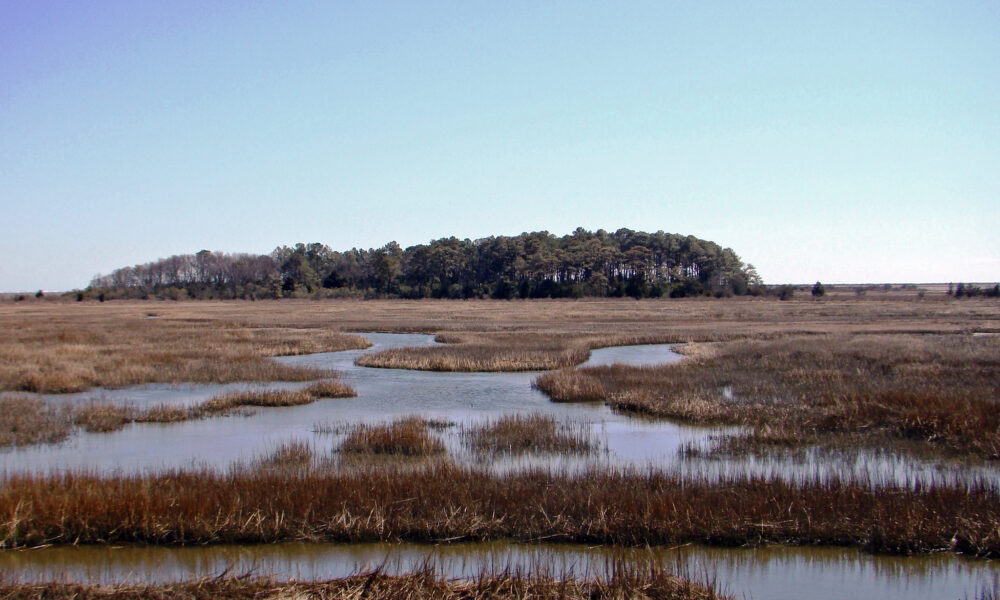Wetlands exist in almost every corner of the United States, representing a total area larger than the state of California. While some have federal or state protection, many do not. And despite the proximity of wetlands to many communities in this country, few people truly understand either the value wetlands hold for our way of life or the threat they face from our industrialized system of agriculture.
One person who does is Stacy Woods, research director for the Food and Environment Program at the Union of Concerned Scientists. A geostatistican by training, Dr. Woods brings decades of experience in the application of spatial data science to her work studying the environmental and health impacts of the US food and agriculture system. She holds a PhD in environmental health engineering from the Johns Hopkins Bloomberg School of Public Health, was a policy fellow at the National Academies of Sciences, Engineering, and Medicine, and has also worked for the US Environmental Protection Agency (EPA).
I spoke with her about the results of her new UCS report, Wetlands in Peril.
AAS: As we go about our daily lives, it might be tempting to look at an expanse of wetlands and just write it off as so much empty “swamp.” Why are wetlands important?
STACY WOODS: We all benefit from wetlands. Wetlands help mitigate climate change by trapping and storing carbon. They also provide habitats for roughly half of endangered species, from cranes to crocodiles, and 75% of harvested fish and shellfish.
Wetlands help prevent water pollution by filtering harmful pollutants before they get into our drinking water systems. And wetlands also help protect us from flooding. Their spongy soils and water-loving plants absorb heavy rains and snowmelt, slowly releasing it into groundwater and nearby waterways and preventing it from rushing into our communities and homes.
AAS: How are wetlands being threatened?
STACY WOODS: The US has lost half of its wetlands since its founding. While development, forestry, and climate change all contribute to wetland loss, draining for agriculture has been the single biggest cause since the 1800s. Today, large corporate agribusinesses drain wetlands to expand their vast cropland and damage remaining wetlands with fertilizers, pesticides, and other pollutants running off of nearby agricultural fields.
Agriculture’s devastating toll is evident in the Prairie Pothole Region of the Upper Midwest, where it caused 95% of wetland loss between 1997 and 2009. Wetlands in the United States are now even more vulnerable after the Supreme Court’s 2023 decision in Sackett v. Environmental Protection Agency that stripped Clean Water Act protections from many inland wetlands.
By destroying wetlands, industrial agriculture robs communities of natural flood protections—just as climate change fuels more frequent and severe floods, like those in the summer of 2024 that devastated communities, destroyed crops, and claimed lives in Iowa, Minnesota, and South Dakota.
AAS: In terms of the financial value that wetlands provide by protecting communities from flooding, how much did your research determine is at stake?
STACY WOODS: Yes. We estimated that the 30.4 million acres of wetlands in the Upper Midwest prevent almost $23 billion in flood damage to residential properties every year, amounting to an estimated $323 billion to $754 billion in long-term savings. And we only considered wetlands’ natural flood mitigation, so these estimates don’t include wetlands’ benefits to water quality, climate resilience, recreation, wildlife, or commercial fishing.
AAS: What do these findings mean for the rest of the country?
STACY WOODS: Our report focused on flood mitigation benefits in the Upper Midwest, but wetlands protect communities across the country. Destroying them removes these natural flood defenses, leaving communities more exposed to extreme weather.
But wetland loss doesn’t just increase flood risk—it also drives climate change. Wetland soils hold 30% of the world’s carbon despite covering only 6% of its surface. When wetlands are damaged or destroyed, that stored carbon is released into the atmosphere, where it traps heat, warms the planet, and fuels extreme weather, including catastrophic floods.
So we see the impacts of wetland loss compound over time—wetland destruction drives climate change, climate change intensifies flooding, and with fewer wetlands to absorb floodwaters, flood damage becomes even more devastating.
Wetland loss also deepens existing inequalities. In communities across the United States, systemic racism in housing policies, combined with inadequate environmental and infrastructure planning, leaves communities of color and low-income residents disproportionately vulnerable to flooding, and wetland loss exacerbates this risk. For example, in Michigan, the destruction of wetlands has worsened flooding in predominantly Black and under-resourced neighborhoods. And to make matters worse, socially vulnerable communities are less likely to receive federal disaster aid after a catastrophic flood, further deepening systemic inequalities.
AAS: What can be done to stop this vicious cycle?
STACY WOODS: Since agriculture is a leading cause of wetland loss, the US Department of Agriculture (USDA) is uniquely positioned to help conserve wetlands. USDA conservation programs can successfully protect and restore wetlands—these programs drive the majority of newly created or rehabilitated wetlands in the Upper Midwest. But, despite their success and their popularity among farmers, current funding levels for these conservation programs are insufficient to stem wetland loss in the United States, which has accelerated over the last 20 years.
The federal food and farm bill offers a pivotal opportunity to protect our country’s wetlands by adequately funding USDA conservation programs. For example, the Farmable Wetlands Program helps farmers restore wetlands on their land. Other USDA conservation programs like the Conservation Stewardship Program help farmers adopt soil-friendly farming techniques, which improve soil health and reduce pesticide and fertilizer runoff into wetlands and other waterways.
Since Congress is currently working on the next farm bill, now is the time for people to call or write their representatives and urge them to pass a farm bill that strengthens the conservation programs that support healthy crops, healthy soil, healthy water, and healthy wetlands.

